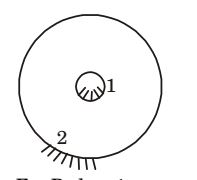Heat Transfer Miscellaneous
- Consider a two-dimensional laminar flow over a long cylinder as shown in the figure below.

The free stream velocity is U∞ and the freestream temperature T∞ is lower than the cylinder surface temperature T∞. The local heat transfer coefficient is minimum at point
-
View Hint View Answer Discuss in Forum
For laminar flow, the heat transfer coefficient is minimum where the boundary layer thickness is maximum and vice versa. For turbulentregion boundary layer thickness is maximum at 3 but for laminar boundary layer thickness is maximum at 2 so minimum heat transfer coefficient.
Correct Option: B
For laminar flow, the heat transfer coefficient is minimum where the boundary layer thickness is maximum and vice versa. For turbulentregion boundary layer thickness is maximum at 3 but for laminar boundary layer thickness is maximum at 2 so minimum heat transfer coefficient.
- A spherical steel ball of 12 mm diameter is initially at 1000 K. It is slowly cooled in a surrounding of 300 K. The heat transfer coefficient between the steel ball and the surroundings is 5 W/m²K. The thermal conductivity of steel is 20 W/mK. The ternperature difference between the centre and the surface of the steel ball is
-
View Hint View Answer Discuss in Forum
Bi = hL = 5 ×0.002 = 0.0005 K 20
For the given condition, Biot number tends to zero, i.e. conduction resistance is far less than convection resistance. Therefore temperature between centre and surface is very small.Correct Option: D
Bi = hL = 5 ×0.002 = 0.0005 K 20
For the given condition, Biot number tends to zero, i.e. conduction resistance is far less than convection resistance. Therefore temperature between centre and surface is very small.
- Water flows through a tube of diameter 25 mm at an average velocity of 1.0 m/s. The properties of water are ρ = 1000 kg/m³, μ= 7.25 × 104 Ns/m², k = 0.625 W/mK, Pr = 4.85. Using Nu = 0.023 Re0.8 Pr0.4, the convective heat transfer coefficient (inW/m²K) is _______
-
View Hint View Answer Discuss in Forum
Re = ρVD μ = 1000 × 1 × 25 × 10-3 7.25 × 10-4
= 34482.75
Pr = 4.85
Nu = 0.023 Re0.8 Pr0.4.
Nu = .0.23 × (34482.758)0.8 (4.85)0.4.
= 184.546& Nu = hd k h = Nu.k d = 184.546 × 0.625 25 × 10-3 = 4613.66 W m²K Correct Option: B
Re = ρVD μ = 1000 × 1 × 25 × 10-3 7.25 × 10-4
= 34482.75
Pr = 4.85
Nu = 0.023 Re0.8 Pr0.4.
Nu = .0.23 × (34482.758)0.8 (4.85)0.4.
= 184.546& Nu = hd k h = Nu.k d = 184.546 × 0.625 25 × 10-3 = 4613.66 W m²K
- A 0.2 m thick infinite black plate having a thermal conductivity of 3.96 W/m-K is exposed to two infinite black surfaces at 300 K and 400 K as shown in the figure. At steady state the surface temperature of the plate facing the cold side is 350 K. The value of Stefan-Boltzmann constant a is 5.67 × 10–8 W/m² K4. Assuming 1- D heat conduction, the magnitude of heat flux through the plate (in W/m²) is ______(correct to two decimal places).

-
View Hint View Answer Discuss in Forum
Heat flux through the wall} = heat flux from wall to surface at 300 k
= × σ(3504 - 3004) 1 + 1 - 1 1 1 = 391.612 w (∵ 6 = 5.67 × 10-8 w m² m²k4 Correct Option: C
Heat flux through the wall} = heat flux from wall to surface at 300 k
= × σ(3504 - 3004) 1 + 1 - 1 1 1 = 391.612 w (∵ 6 = 5.67 × 10-8 w m² m²k4
- The shape factors with themselves of two infinitely long black body concentric cylinders with a dia ratio of 3 are _____ for the Inner and _____ for the outer
-
View Hint View Answer Discuss in Forum
d2 = 3 d1 
For Body – 1
F11 + F12 = 1
F12 = 1 (∵ F11 = 0)For Body - 2 F21 + F22 = 1 - (A)
By applying reciprocity theorem,
A1 F12 = A2 F21
A1 = A2 F21or F21 = A1 = πd1l = d1 = 1 A2 πd2l d2 3 F21 = 1 3 Substituting, F21 = 1 in(A),weget 3 1 F22 = 1 3 F22 = 2 3 Correct Option: B
d2 = 3 d1 
For Body – 1
F11 + F12 = 1
F12 = 1 (∵ F11 = 0)For Body - 2 F21 + F22 = 1 - (A)
By applying reciprocity theorem,
A1 F12 = A2 F21
A1 = A2 F21or F21 = A1 = πd1l = d1 = 1 A2 πd2l d2 3 F21 = 1 3 Substituting, F21 = 1 in(A),weget 3 1 F22 = 1 3 F22 = 2 3

